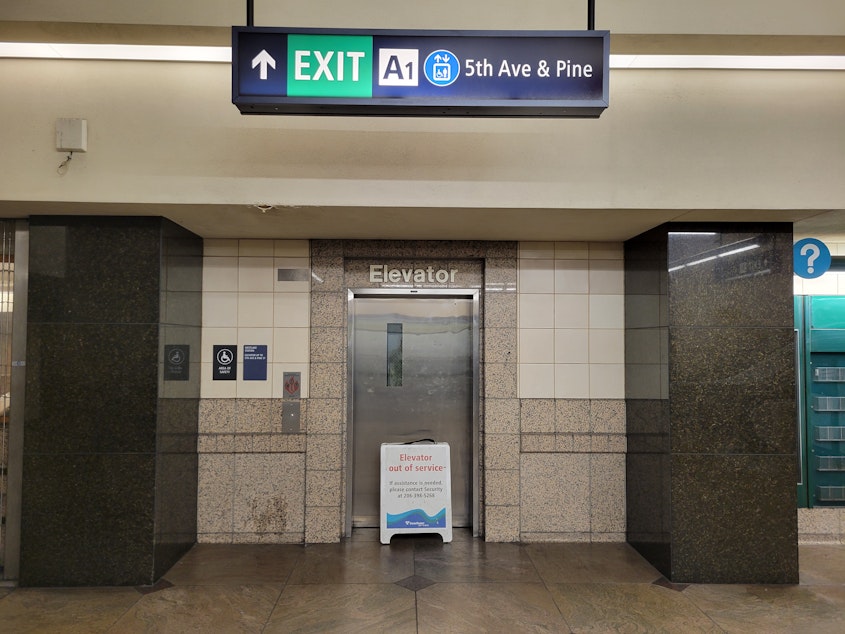What's going on with the escalators at Seattle light rail stations?

Broken elevators and escalators have been a common headache for Sound Transit riders, and have plagued the Seattle area light rail system for years.
While the agency aims to have 95 percent of escalators, and 97 percent of elevators running on a given day, the current outages are roughly twice that rate.
We talk with Sound Transit about these issues, but first wanted to get the perspective of the people most negatively affected when an elevator or escalator is out of service.
Dr. Anat Caspi, director of the University of Washington's Taksar Center for Accessible Technology, is acutely aware of how a hiccup with an elevator can lead to an "adventure" trying to exit the light rail station.
"I actually traveled to Westlake Center with my daughter who uses a wheelchair several years back," Caspi explained. "We managed to get the elevator to the mezzanine level, but then the next elevator out into the street level was boarded up and inaccessible. So, we were trying to find a different way to get out onto the street.
"We found an additional elevator that was working, but it only took us into the Nordstrom that's at the base of Westlake. We managed to find our way out first having to go through the second floor of Westlake and of course visiting the candy store.
"So, if the mall had been closed, we probably would have had to extend our trip even further for many trial and errors, or maybe had to have turned back and if we hadn't found a way out."
Many people who don't rely on mobility aids to get around in their daily lives can generally overcome obstacles like an out-of-service escalator, but when you need the elevator to get out of an underground light rail system, outages make spontaneous trips that much more difficult.
Sponsored
Kenny Salvini, co-founder and president of the Here & Now Project, has been using a wheelchair for 18 years after being paralyzed in a skiing accident.
He said planning trips starts with the question, "Is there access?"
"Access is everything," Salvini said. "You know, one little hiccup can pretty much cancel an entire trip and all of your plans."
Accessibility isn't only limited to people who use mobility aids, either. Every day 10,000 Americans turn 65, and disabilities of one sort or another become more common as we age. Things like curb cutouts are a convenience for non-disabled people, from parents pushing strollers to delivery drivers using them to push carts full of packages. But according to Salvini, "convenience for able-bodied people is independence for people with all sorts of ability issues and disabilities as a whole. The more we look at Universal Design, it gives everybody a little bit more independence and inclusion."
And that's where Sound Transit is stepping in.
Sponsored
John Carini, deputy director of Vertical Conveyances, said Sound Transit is working on a plan to be able to monitor the status of elevators and escalators in real time.
"We have a pilot program going on right now at Beacon Hill," Carini explained. "A new hardware and software solution that's installed on the equipment that has given us live updates right now about how the equipment is doing, how is the ride quality, how many trips has it taken that day? When is it most in use? Two o'clock in the afternoon versus 6 a.m.? And also, the number one thing is — is it running or is it not running?"
That's an important part of the puzzle, because once that information is easily accessible, riders can know immediately where to get on or off based on what sort of option they need to enter or exit a station.
This will also play a big role in the upcoming expansions to the light rail system, with stations in Ballard and West Seattle. According to current proposals, some of those stations could be anywhere from 120 feet deep to 85 feet up in the air. Carini said they're learning lessons from the newest stations they've opened, and are building in redundancies.
He also encourages riders to let Sound Transit know when issues occur.
Sponsored
"I would encourage passengers to let us know when there's an outage," Carini said. "We rely on those communications to get the vendor out there and get the equipment back turned on. So, anytime they see it, feel free to send a tweet out or reach out to Sound Transit."
Hear the full story from Soundside's episode by clicking the audio above.





